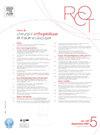Évaluation de la trophicité et de la fonction du muscle sub-scapulaire après intervention de Trillat arthroscopique
Q4 Medicine
Revue de Chirurgie Orthopedique et Traumatologique
Pub Date : 2025-02-01
DOI:10.1016/j.rcot.2024.07.022
引用次数: 0
Abstract
Introduction
Plusieurs séries ont rapporté une diminution de force des rotateurs médiaux (RM) dans les suites d’une intervention de Latarjet, pouvant persister à distance de l’intervention. La technique de Trillat arthroscopique, ne nécessitant pas de split du muscle sub-scapulaire, est potentiellement moins agressive pour celui-ci.
Hypothèse
L’intervention de Trillat arthroscopique n’engendre pas d’amyotrophie ni de diminution de force du muscle sub-scapulaire.
Matériel et méthodes
Une étude rétrospective, monocentrique, entre 2013 et 2021 a été menée. Étaient inclus les patients présentant une instabilité antérieure chronique d’épaule avec indication de stabilisation par technique de Trillat arthroscopique et ayant bénéficié d’un scanner préopératoire et à 6 mois de la chirurgie. Les paramètres morphologiques suivants ont été mesurés sur tous les muscles de la coiffe des rotateurs : section transversale musculaire (CSA), épaisseur et évaluation de la dégénérescence graisseuse selon la mesure de l’atténuation musculaire moyenne (AMM). Des tests isocinétiques ont par la suite été réalisés à 1 an de la chirurgie.
Résultats
Au total, 117 patients ont bénéficié d’une chirurgie de Trillat arthroscopique de 2013 à 2021, 58 ont été inclus, 30 analysés et 17 patients ont réalisé les tests isocinétiques. Une diminution significative de la CSA du muscle sub-scapulaire a été mesurée (17 vs 16,1 ; p = 0,03) avec une diminution de 5,3 %. Aucune diminution significative de CSA n’a été mesurée sur les autres muscles de la coiffe des rotateurs. Une augmentation significative de l’AMM du sub-scapulaire alors qu’une diminution de l’AMM des rotateurs latéraux (RL) a été mesurée en postopératoire. Aucune diminution de force n’a été retrouvée à 1 an de l’intervention, que ce soit sur les rotateurs médiaux ou latéraux.
Discussion
L’intervention de Trillat arthroscopique engendre une amyotrophie faible du muscle sub-scapulaire à 6 mois, sans diminution de force à 1 an de l’intervention. Plusieurs études rapportent une diminution de force en rotation interne après intervention de Latarjet, de 6 à 19 % à la fin de l’évaluation et suivant les séries.
Niveau de preuve
IV.
Introduction
Several studies have reported a strength deficit in internal rotation (IR) following a Latarjet procedure, which can persist for months or even years. The arthroscopic Trillat procedure does not require splitting the subscapularis muscle, potentially making it less damaging.
Hypothesis
The arthroscopic Trillat procedure does not cause any atrophy or strength deficit in the subscapularis muscle.
Methods
This was a single center, retrospective study of patients treated between 2013 and 2021. Included were patients who had chronic anterior shoulder instability with an indication for surgical stabilization using an arthroscopic Trillat procedure and who underwent a CT scan before surgery and a second one at 6 months postoperative. The following morphological parameters were measured on all the rotator cuff muscles: cross-sectional area (CSA), thickness and fatty infiltration using the mean muscle attenuation (MMA) measurement. Isokinetic tests were done 1 year post-surgery.
Results
One hundred seventeen patients underwent arthroscopic Trillat surgery between 2013 and 2021; 58 were included, 30 were analyzed and 17 patients underwent isokinetic testing. The CSA of the subscapularis was significantly smaller by 5.3% (17.0 vs. 16.1; p = 0.03). None of the other rotator cuff muscles had a smaller CSA. The MMA of the subscapularis increased significantly while the MMA of the external rotators decreased postoperatively. No strength deficit was found at 1 year postoperative in the internal and external rotators.
Discussion
The arthroscopic Trillat procedure produces minor atrophy of the subscapularis muscle at 6 months, with no strength deficit at 1 year postoperative. Several studies have reported a deficit in internal rotation strength after a Latarjet procedure, ranging from 6% to 19% depending on the study.
Level of evidence
IV.
关节镜Trillat手术后肩胛骨下肌肉的营养和功能评估
几个系列报告说,在Latarjet干预后,中旋翼(RM)的功率下降,可能在远离干预的地方持续。关节镜Trillat技术不需要对肩胛骨下肌肉进行分裂,对肩胛骨下肌肉的攻击可能较小。假设Trillat关节镜手术不会导致肌萎缩或肩胛骨下肌肉力量下降。2013年至2021年进行了单中心回顾性研究。包括术前6个月接受术前扫描、术前6个月接受关节镜Trillat稳定适应症的慢性前部肩部不稳定患者。在旋转帽的所有肌肉上测量了以下形态学参数:肌肉横截面(CSA)、厚度和根据平均肌肉衰减(AMM)测量的脂肪退化评估。术后1年进行等运动学测试。从2013年到2021年,共有117例患者接受了关节镜Trillat手术,58例纳入,30例分析,17例进行了等运动学检测。肩胛骨下肌CSA显著下降(17 vs 16.1;P = 0.03),下降5.3%。在转子帽的其他肌肉上没有观察到CSA的显著下降。术后测量到肩胛骨下AML显著增加,而侧旋(LR) AML下降。干预1年后,中侧或侧转子均未发现动力下降。讨论Trillat关节镜手术在6个月时引起肩胛骨下肌肉的弱肌萎缩,手术1年后没有力量减弱。几项研究报告说,在Latarjet干预后,内部旋转力减少了6 - 19%,在评估结束时和后续系列。证据四。一些研究报告了Latarjet手术后的内转(IR)强度不足,这种情况可能持续数月甚至数年。关节镜Trillat手术不需要分裂肩胛骨下肌肉,可能使其损害较小。假设关节镜Trillat手术不会引起肩胛骨下肌肉的任何萎缩或力量不足。这是一项关于2013年至2021年接受治疗的患者的单一中心回顾性研究。包括慢性肩前不稳定患者,使用关节镜Trillat手术进行手术稳定适应症,以及术前CT扫描和术后6个月第二次CT扫描的患者。使用平均肌萎缩侧索硬化症(MMA)测量所有旋转袖肌的形态参数:横截面面积(CSA)、厚度和脂肪浸润。术后1年进行异动测试。结果:2013年至2021年,117例患者接受了关节镜颤动手术;58例纳入,30例分析,17例接受等动力检测。肩胛骨下CSA明显小5.3% (17.0 vs. 16.1;P = 0.03)。其他旋转袖肌都没有比CSA更小的。手术后,肩胛骨下的MMA显著增加,而外部转子的MMA下降。术后1年,内、外转子均无强度不足。讨论关节镜Trillat手术在6个月时产生轻微的肩胛骨下肌肉萎缩,在术后1年没有力量不足。几项研究报告了Latarjet手术后的内部旋转强度的不足,根据研究的不同,从6%到19%不等。第四章。
本文章由计算机程序翻译,如有差异,请以英文原文为准。
求助全文
约1分钟内获得全文
求助全文
来源期刊

Revue de Chirurgie Orthopedique et Traumatologique
Medicine-Surgery
CiteScore
0.10
自引率
0.00%
发文量
301
期刊介绍:
A 118 ans, la Revue de Chirurgie orthopédique franchit, en 2009, une étape décisive dans son développement afin de renforcer la diffusion et la notoriété des publications francophones auprès des praticiens et chercheurs non-francophones. Les auteurs ayant leurs racines dans la francophonie trouveront ainsi une chance supplémentaire de voir reconnus les qualités et le intérêt de leurs recherches par le plus grand nombre.
 求助内容:
求助内容: 应助结果提醒方式:
应助结果提醒方式:


